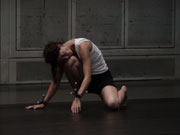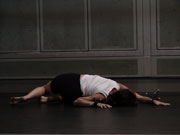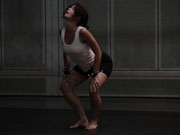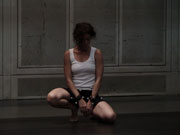Collaborations - Research
Research in various contexts has always helped Jane access new insight into her process and her work. She wants to challenge herself to try new things, to observe how other artists work, practice adapting within different working processes and use these opportunities to take risks.
Ircam (from 2003)
Jane has been fortunate to collaborate with scientists of the Room Acoustic team at ircam, Paris since 2003 on a research process involving different real time interactive audio rendering systems.
The last session, held in July 2009, enabled the team to test several ideas linking generative music, choreography and a Wave Field Synthesis (WFS) system equipped with 128 loudspeakers. The WFS technique is a type of holophonic reproduction process that enables, by analogy with visual holograms, the capture or synthesizing of a sound scene while conserving the spatial characteristics of distance and direction. This system is combined with another system for motion capture with infrared cameras. The technology the team were researching into, emphasises the importance of the spatial dimension of sound and the way it can interact with the body. For Jane, having increased awarenesss into stimulating the presence and perception of the audience by making obvious how sound, space and movements are intermingled has been a major influence in the development of her work.
Viaud−Delmon I., Mason J., Haddad K., Noisternig M., Bevilacqua F., Warusfel O. (in press) A sounding body in a sounding space: the building of space in choreography – focus on auditory−motor interactions, Electronic Dance Research, Special Issue: Dance and Neuroscience − New Partnerships.
Jane’s response to working with the technology.
It is constant communication. My thinking and my dancing is transforming in the moment. Atmospheres and intensities shift frequently not because different music is playing but because I’m implicated in those varying qualities, I cause it, I create it. Being agent of the musical compositions and noticing where that leads me, informing how I inhabit and perceive the space creates a highly immersive and rigorous connectedness. It’s interesing how the interactivity provides me with physical and mental feed back clearly affecting my progressive choreographic choices and how I organise myself differently in space, with much more detail, because of it. Sensing the aliveness of the stage area in such a powerful way is a highly stimulating and atmospheric area to work in.
The systems don’t tell the dancer how to move. The dancer must enter the live programmed zones through the language of dance and use his or her body to direct an individual manipulation/journey/discovery/route etc within the defined stage area.
What the systems can and do, is rigorously encourage a direction, provoke a quest, offer a particular predicament to solve, lure, baffle, disrupt, partner etc, but the choice of exactly how to move is the dancer’s. For example, how to organise the search choreographically when the mappings have intentionally been kept hidden, when to pause or return to a familiar place in an attempt to recreate an idea, develop it or try to locate a particular sound in space again. What is it like to hover on a border directly ‘in’ the sound whilst making it? for how long? when to attack with a different quality, provoke a change, collide into and through a particular spatial area? attempt to identify the tiniest of sounds in space and explore them imaginatively? All these factors affect a dancer’s motivations on so many levels and were not prescribed. I like to make order out of improvisational structures and to create something that can generate meaning. Therefore in choreographic/performative terms there was so much to practice and to integrate working with here.
May (2010)
Probe.
Dancer within Antonia Grove’s collaborative process working with Tim Crouch’s new script Cut and Drawn, with Guy Dartnell, Pete Shenton and Scott Smith.
Big Intensive (2008)
Invited week-long international workshop on ‘Directing Dance’.
Sadler’s Wells.
Dance Lines (2008)
A choreographic training programme directed by Wayne McGregor.
Royal Opera House.
SPCP (Solo Performance Commissioning Project 2007)
Choreographic process with Deborah Hay learning her solo The Runner.
Findhorn, Scotland.
m&de @ Dartington (Music and Dance Exchange 2005)
Participant in M&DE, a performer-led research lab for cross-disciplinary performance co-directed by Emilyn Claid and Chris Best.
Rust (2005)
Dancer in a research collaboration between choreographer Charlotte Vincent and visual artist Gerard Renvez.
Colina (Collaboration in Arts 2004)
Participant in an invited two-week international research lab held in Rui Horta’s Monastery in Montemor-o-Novo, Portugal.



